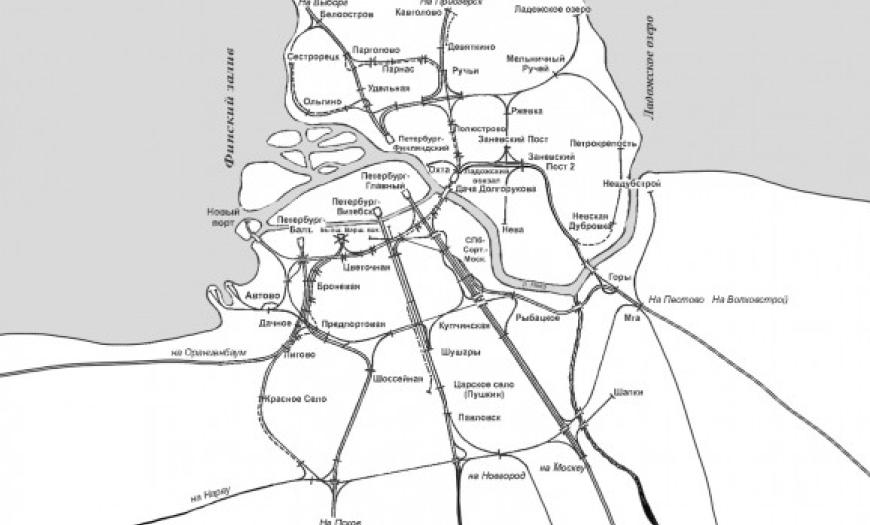Since the middle of the last century, Lengiprotrans has been developing a general scheme for the development of the St. Petersburg (formerly Leningrad) railway junction. In the 1960-1970s, the institute developed a general layout of the unit for the estimated 1980-1985 with a forecast up to 2000. On February 5, 1970, the junction layout was approved by the Ministry of Railways.
The general layout of the node was developed in conjunction with the needs of the city, in addition to transport problems, important environmental problems were solved. In accordance with it, the transfer of freight, long-distance passenger traffic and shunting operations to electric and diesel traction was carried out. The electrification of 400 km of suburban traffic was carried out and was fully completed by 1980. Work was carried out to equip railway sections with dispatch centralization, automatic blocking and equip 14 stations with electrical interlocking.
The following works have been carried out on the development of the passenger devices of the unit:
• Interchange stations (railway - metro) were built Kupchino (1972), Devyatkino (1977), Rybatskoe (1983), Udelnaya (1983);
• Stopping passenger points were built, Prospekt Slavy (1970), Bronevaya, Prospekt Lenin, Airport, Ulyanka (1971), University (1972);
• at the Leningrad-Passenger-Moskovsky station, the light hall of the station was reconstructed, two passenger platforms were reconstructed and sheds over them were erected (1969-1972).
On the development of marshalling and port yards:
• at the Leningrad-Sortirovochny-Moskovsky station, the head of the sorting yard of the even system was rebuilt with the implementation of work on the automation of the even-numbered hill, the tracks of the receiving parks and the sorting odd-numbered system were lengthened and the odd hill was automated; completed work on laying 7 additional sorting tracks in an even sorting yard (1978-1982);
• at Shushary station, additional tracks were laid in the receiving park, tracks in the sorting park were lengthened, the sorting hump was mechanized with the equipment of its automatic hump centralization devices (1971-1977);
• at the Novy Port station, a new receiving and dispatching yard was built (1976-1978).
For the development of the cargo economy:
• a new mechanized cargo yard was built at the Shushary station (1978);
• a container processing terminal was built at the Leningrad-Tovarny-Vitebsky station (1977);
• a new container yard was built at the Leningrad-Tovarny-Finlyandsky station (1978);
• at Dacha Dolgorukova station, a site for heavyweights and timber was built (1976);
• the motor car depot at the Leningrad-Passenger-Moskovsky station was reconstructed (1979), the first stage of the repair and equipment depot of this station was built (1977).
On increasing the capacity of railway approaches and the construction of overpasses:
• second tracks were built on the Piskarevka - Ruchyi (2.3 km) and Piskarevka - Rzhevka (5.0 km) sections (1971-1975);
• overpasses were built at the intersections of the Central Arc Highway with the tracks of the Leningrad-Sortirovochny-Moskovsky station (1975), Svetlanovsky Prospekt with the main tracks of the Vyborg direction (1972), Bukharestskaya Street with the tracks of the Volkovskaya station (1975), Ligovsky Prospekt with the main tracks Vitebskaya line (1974), Leningrad Moscow highway with the tracks of Sredne-Rogatskaya station (1984), Leninsky prospect and Narodnogo Opolcheniya street with the tracks of the Predportovaya - Narvskaya stretch (1974).
However, the most difficult problems outlined by the general scheme, such as the construction of a new passenger station Leningrad-Ladozhsky, the liquidation of the Leningrad-Varshavsky station with the corresponding development of the Leningrad-Passenger-Vitebsky and Leningrad-Passenger-Baltic stations and the construction of a new marshalling station Leningrad-Yuzhny, were not resolved for economic reasons.
Author's department:
Project Status:


